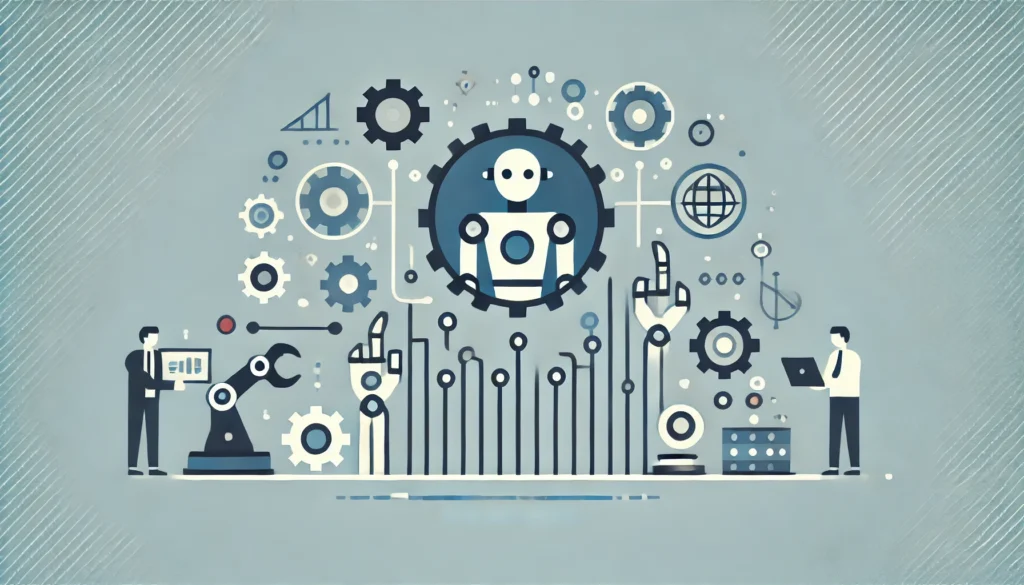Businesses have always invested in advanced tools to streamline operations, enhance customer experiences, and reduce costs. But it feel like we’re on the cusp of something big here with the advent of GPTs and AI processes. Enter, hyperautomation — a concept that is quickly gaining traction across various industries. But what exactly is hyperautomation, and how will it impact your industry?
Understanding Hyperautomation
Hyperautomation refers to the comprehensive approach of automating as many business processes as possible using a combination of advanced technologies. Unlike traditional automation, which focuses on automating specific tasks, hyperautomation takes a broader, more integrated approach. It leverages a wide array of tools and technologies, including artificial intelligence (AI), machine learning (ML), robotic process automation (RPA), low-code/no-code platforms, and other digital tools, to automate complex business processes across an entire organization.
The Evolution from Automation to Hyperautomation
While automation typically targets individual tasks—such as data entry, invoicing, or customer support—hyperautomation aims to automate end-to-end processes across departments and functions. This shift from isolated automation to a more connected and intelligent approach allows businesses to achieve greater efficiency, accuracy, and scalability. With hyperautomation, the goal is to create a digital ecosystem where processes are not only automated but also continuously improved and optimized through the use of AI and ML.
Key Components of Hyperautomation
Hyperautomation relies on a combination of technologies to drive process automation at scale. Here are some of the key components:
- Artificial Intelligence (AI): AI enables machines to mimic human intelligence, allowing for smarter decision-making and predictive analytics. In the context of hyperautomation, AI is used to analyze data, recognize patterns, and make informed decisions without human intervention.
- Machine Learning (ML): ML algorithms learn from data and improve over time, making them essential for automating complex processes that require continuous optimization. ML can be used to enhance various aspects of business operations, from customer service to supply chain management.
- Robotic Process Automation (RPA): RPA uses software robots to automate repetitive, rule-based tasks. When combined with AI and ML, RPA can handle more complex tasks that require decision-making capabilities, enabling the automation of processes that were previously thought to require human intervention.
- Low-Code/No-Code Platforms: These platforms allow users to create and deploy applications with minimal coding, making it easier for non-technical employees to contribute to automation efforts. This democratization of automation accelerates the implementation of hyperautomation across an organization.
- Data Analytics and Process Mining: By analyzing vast amounts of data, businesses can identify inefficiencies and areas for improvement. Process mining tools help organizations map out existing processes, enabling them to optimize and automate them more effectively.
6 Ways Hyperautomation Will Impact the Future of Business
1. Enhanced Efficiency and Productivity
Hyperautomation enables businesses to automate complex processes that involve multiple tasks and departments, significantly enhancing efficiency and productivity. By reducing the reliance on manual work, organizations can redirect human resources to more strategic and creative tasks, ultimately driving innovation and growth.
2. Improved Customer Experience
With hyperautomation, businesses can offer faster, more personalized customer service. AI-powered chatbots, for instance, can handle customer inquiries 24/7, providing instant responses and freeing up human agents to address more complex issues. This level of service not only improves customer satisfaction but also strengthens brand loyalty.
3. Cost Reduction
Automating processes at scale leads to significant cost savings. By minimizing human involvement in routine tasks, businesses can reduce labor costs and eliminate errors, which often lead to costly rework. Additionally, hyperautomation allows organizations to optimize resource allocation, further reducing operational expenses.
4. Scalability and Flexibility
As businesses grow, their processes become more complex. Hyperautomation provides the scalability needed to handle this complexity by automating processes that can easily adapt to changing demands. Whether it’s scaling up production, managing a growing customer base, or expanding into new markets, hyperautomation ensures that operations remain efficient and responsive.
5. Data-Driven Decision Making
Hyperautomation enables businesses to leverage data in real-time, providing valuable insights that inform decision-making. AI and ML algorithms can analyze vast amounts of data, identifying trends and patterns that may not be immediately apparent to human analysts. This data-driven approach allows businesses to make more informed decisions, leading to better outcomes.
6. Resilience and Adaptability
In an increasingly volatile business environment, resilience is crucial. Hyperautomation equips organizations with the tools needed to quickly adapt to changes, whether it’s a sudden shift in market conditions or a global pandemic. By automating critical processes, businesses can maintain continuity and minimize disruptions.
The Challenges of Hyperautomation
While the benefits of hyperautomation are significant, implementing it is not without challenges. Here are a few considerations businesses must keep in mind:
- Integration Complexity: Hyperautomation involves integrating multiple technologies and platforms, which can be complex and time-consuming. Businesses must ensure that their IT infrastructure is capable of supporting such integrations.
- Change Management: Transitioning to hyperautomation requires a shift in organizational culture. Employees may be resistant to change, particularly if they fear job displacement. Effective change management strategies are essential to ensure a smooth transition.
- Security and Compliance: Automating processes that handle sensitive data introduces new security risks. Businesses must prioritize cybersecurity and ensure that their hyperautomation efforts comply with relevant regulations and standards.
The Future is Hyperautomated
As businesses continue to seek ways to improve efficiency, reduce costs, and enhance customer experiences, hyperautomation will play an increasingly vital role. By leveraging a combination of AI, ML, RPA, and other digital tools, organizations can transform their operations and stay competitive in a rapidly changing market.
Incorporating hyperautomation into your business strategy for 2024 and beyond may well be the key to staying ahead of the curve in an increasingly digital world.
